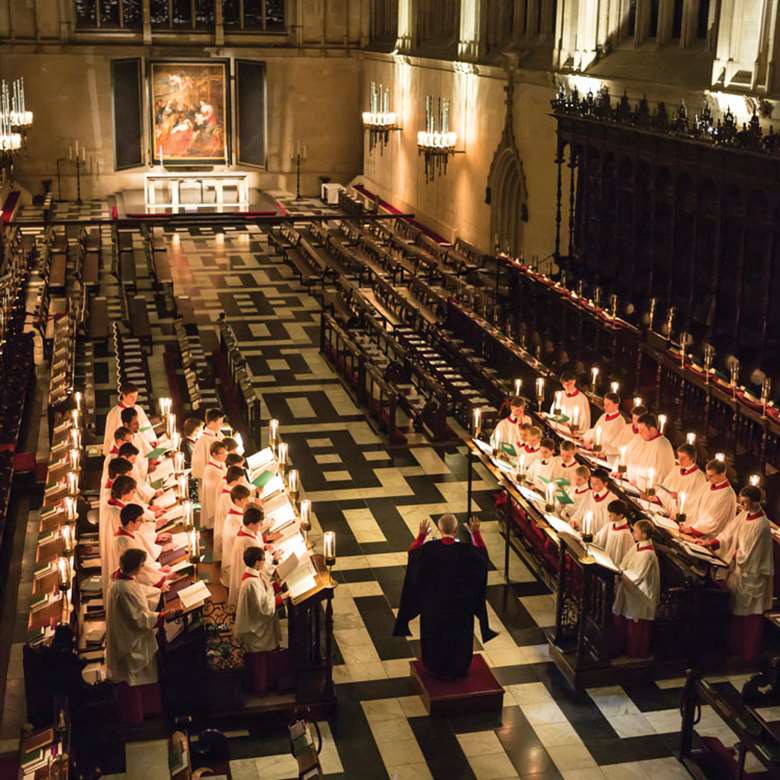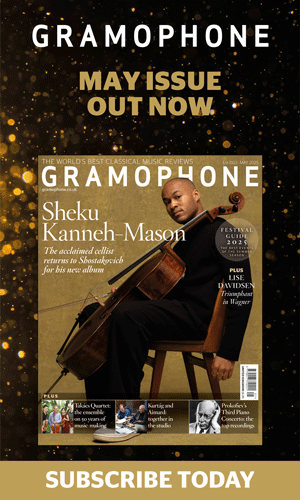Christmas carols: a thriving tradition
Ivan Moody
Wednesday, December 12, 2018
We live in a golden age of Christmas carol composition. Ivan Moody considers the challenges of writing new seasonal music and the ways in which they are met by today’s composers

Almost a decade ago, I threw up my hands in despair at the triteness of recorded Christmas fare and decided to write a carol. I did so, and faxed it to a conductor friend as soon as it was finished. Its first performance took place that very Christmas at the Chapel of the Royal Hospital, Chelsea, and I have written a new carol every year since then. Other composers have clearly felt the same frustrations, with the result that the sheer quantity of new music for Christmas produced over the past few years is quite extraordinary.
Negativity is, of course, not a good place to start: the Christmas period especially demands a positive stance, a new and optimistic contribution intended to stand out from, but in some way also be a part of, the traditional offerings. It is refreshing to see, then, just how much music has been written in recent years that has not only refreshed the repertoire but has remained part of it on account of its high quality. The locus classicus for new seasonal music in Great Britain is, of course, the Festival of Nine Lessons and Carols at King’s College, Cambridge, for whose unique format 34 new works, including carols and postludes for organ, have been commissioned to date.
Those commissioned include not only composers whose names resonate through the world of choral music, such as Jonathan Harvey (Angels, 1994), Arvo Pärt (Bogoroditse Devo, 1990), the late Sir John Tavener (Away in a Manger, 2005) and Judith Weir (Illuminare Jerusalem, 1985), but also composers who may seem less obvious choices but who have contributed works of great originality, such as Sir Harrison Birtwistle (The Gleam, 2003), Mark-Anthony Turnage (Misere nobis, 2006) and John Woolrich (Spring in Winter, 2001). Such commissions often bring to light surprising texts, such as Dominic Muldowney’s Mary, written for the 2008 service, which sets a poem by Bertolt Brecht, and they have not always gone to British composers; 2010 brought Christmas Carol from the renowned Finnish composer Einojuhani Rautavaara, and 2012 a setting of Tennyson’s Ring out, wild bells by the Australian composer Carl Vine. Such specially commissioned works naturally receive a great amount of exposure on account of the prestige of the King’s service, which is broadcast live every year on Christmas Eve, and then go on to become part of the standard repertoire; but it is also the case that the commissioning of new music for the Advent and Christmas seasons by choirs of all types and standards is, happily, widespread.
Returning to King’s for the moment, Arvo Pärt is, of course, in many senses an obvious name to seek to commission when thinking of new seasonal works, so prolific has he been as a composer of sacred music. But there is always an element of surprise with Pärt: Bogoroditse Devo is in reality not a Christmas piece at all, merely a setting of the Orthodox version of the Ave Maria. But what a setting! It positively radiates joy, and has gradually become an established feature in Christmas programming, the Slavonic text seeming not to have proved much of an obstacle for Anglophone choirs, and, unsurprisingly, it is also in widespread use in the Orthodox world.
The late Sir John Tavener set Christmas texts a number of times during his life, and of course The Lamb, from 1982, has become a kind of honorary Christmas carol. In later years he set several traditional carol texts, including Rocking and There is no rose, and some of these found their way into the remarkable extended carol sequence Ex Maria Virgine, commissioned by Timothy Brown and the Choir of Clare College, Cambridge, in 2005. This is a substantial work, setting texts taken from a wide variety of sources, though many of them are medieval, and the composer’s settings are by turns meditative and exuberantly dramatic. A typical Tavener touch is his insertion into the final carol, Unto us is born a Son, of salutations to the Virgin Mary in Greek and Arabic.
One can hardly avoid discussing Eric Whitacre in the context of Christmas choral music, but it is often not realised that Whitacre has in fact avoided setting religious texts – the recent Sainte Chappelle for The Tallis Scholars is a remarkable and brilliant exception, but even then the sacred text is a quotation within the poem by Charles Anthony Silvestri – preferring to concentrate instead on evocations of mood, something that could in itself be said to be part of the way Christmas has expanded beyond the Church. Probably the best known of Whitacre’s works, Lux aurumque sets a short poem by Edward Esch, translated into Latin by Silvestri, and was written originally for the Master Chorale at Tampa Bay. Though it clearly refers to Christmas (‘angels sing softly / to the new-born babe’), it is really concerned with the evocation of ‘Light, / warm and heavy as pure gold’ – it is a word-painting, skilfully conveying an atmosphere, and the massive popularity of the work proves that ‘atmosphere’ is something that is considered of great importance in programming choral concerts at this time of year. The Chelsea Carol, a powerful work for choir and organ, is actually a hymn to Wisdom by Silvestri, written for the Choirs of Birmingham-Southern College, to commemorate the 75th anniversary of its own Service of Lessons and Carols, while little tree, for choir and piano, is a setting of a poem by ee cummings in praise of a Christmas tree, written at breakneck speed for the San Francisco Symphony Chorus in 1996.
Whitacre’s avoidance of liturgical or genuinely paraliturgical texts is unusual; but on the other hand, the use of such texts by composers who are not conventional believers is not. Such is the case, famously, of John Rutter, and it is also true of Francis Pott and Gabriel Jackson, both of whom are steeped in the traditions of the Church of England but are not practising Christians. Indeed, Pott says that he is a ‘sort of compositional Richard Holloway [the former Bishop of Edinburgh who latterly adopted an agnostic worldview] these days’, but he has a keen sense of the importance of tradition when he is writing. ‘Most texts applicable in this context,’ he says, ‘will have been set before, sometimes by major composers and in pieces which have come to be regarded as unimprovable classics. In a case like my setting of Balulalow, the impossibility of ignoring Britten’s setting in the Ceremony of Carols arose from the very necessity to ensure that I did something different.’
The whole question of texts is of fundamental importance, too. While Rutter is happy to write his own texts in a modern idiom, and Birtwistle’s carol for King’s set a contemporary poem by Stephen Plaice describing the harsh reality of the birth in the stable rather than any conventional celebratory sentiment, if one turns to extant Christmas texts one is obliged to deal with questions of cultural resonance. Unlike Carl Vine, with his Tennyson setting, or Jonathan Rathbone, whose setting of Hardy’s The Oxen has become established in the repertoire, and who has arranged vast swathes of the traditional carol repertoire, Francis Pott finds that Victorian or Edwardian English texts, for example, do not suit his purpose. ‘By contrast,’ he says, ‘medieval English is sufficiently dissociate in time and cultural resonance to avoid seeming mismatched to new musical settings, provided one approaches it carefully and gets it right (see again Britten and the Ceremony of Carols, where his instinctive feeling for word-setting captures time and again what has become seemingly a definitively right way of doing such things). The same applies even more to Latin, and at least equally to macaronic medieval verse alternating both languages.’ Thus it is that Pott, in common with a large number of composers, has had recourse to well-known medieval texts such as Lullay my liking, There is no rose of such virtue and I sing of a maiden, all of which provide perfect material for his delicate style of text-setting.
A sense of place and occasion is also extremely important for Pott. As a former lay clerk at Winchester Cathedral, he says that ‘imagining them being sung in an appropriate setting’ can be a significant part of responding to a Christmas commission. Gabriel Jackson’s reaction is not dissimilar: ‘I think about other (old or recent) pieces as being in the background of what I am writing, in some way. The personality (as I perceive it) and sound of a liturgical choir, the atmosphere and architecture of its building, the style of worship, have an influence on the piece.’ And it is certainly the case that one can hear these elements that make up so much of the traditional repertoire for Christmas in Jackson’s work, even as one may also discern a distinct freshness: the compound rhythms of The Christ Child, for example, commissioned for King’s in 2009, immediately suggest not only a lullaby but the entire repertoire of the medieval English carol. In fact, Jackson has had recourse to such texts more than once, as Nowell sing we, commissioned by Truro Cathedral in 2006, and Ane sang of the birth of Christ, written for the choir of St Mary’s Episcopal Cathedral, Edinburgh, demonstrate. A Christmas carol should, says the composer, ‘be simple and direct in manner; it should have a clear and straightforward shape’; it might include ‘a verse-and-refrain structure (or, at least, a strong verse structure)…compound metres (with derivatives thereof – 5/8, 7/8…)…a treble solo.’ The Christ Child corresponds to all these requirements but also turns the final verse, with its dramatic change of key and use of repetition at the end, into a moment of sublime transcendence.
One would expect a composer such as James MacMillan, a practising Roman Catholic whose catalogue includes a large amount of sacred and paraliturgical music, to have written for the Christmas season, and such is the case; but it is interesting that his attitude towards doing so contrasts markedly with that of Pott and Jackson. Though he is contemplating writing a large-scale Christmas work in the future, ‘the few pieces I have written so far,’ he says, ‘were undertaken with only the slightest thought for the tradition. I would try to think freshly when it came to Christmas music – the tradition is too thickly and deeply set, and should probably be ignored!’ Challenging words indeed; but the vitality of the result of this approach is evident in the originality of both such an early work as A child is born in Bethlehem, from 1978, scored for three-part choir and oboe, and the much more recent Seinte Mari Moder Milde, commissioned in 1995 for the King’s College Festival of Nine Lessons and Carols. It sets words from a 13th-century manuscript from Trinity College, Cambridge, and features dramatic alternations of darkness and light, intimations of Scottish folksong, a freewheeling and adventurous organ part, and an utterly unexpected ending. Both works are successful and accessible because of MacMillan’s innate melodic gifts, as well as his feeling for atmospheric colour.
Even more colourful, however, is Hodie puer nascitur, a non-liturgical work written for the early music ensemble Las Huelgas and the Royal Concertgebouw Orchestra in 2011. This sets a text from one of the 14th-century French-Cypriot antiphons in the Turin manuscript J.II, and also takes its musical cues from there. There is much use of free rhythm, and the percussive, treble-orientated scoring creates a singular and mysteriously beautiful sound world.
The tradition not only continues but shines brighter than ever.
This article originally appeared in the December 2014 issue of Gramophone. To find out more about subscribing to the world's leading classical music magazine, please visit: magsubscriptions.com







